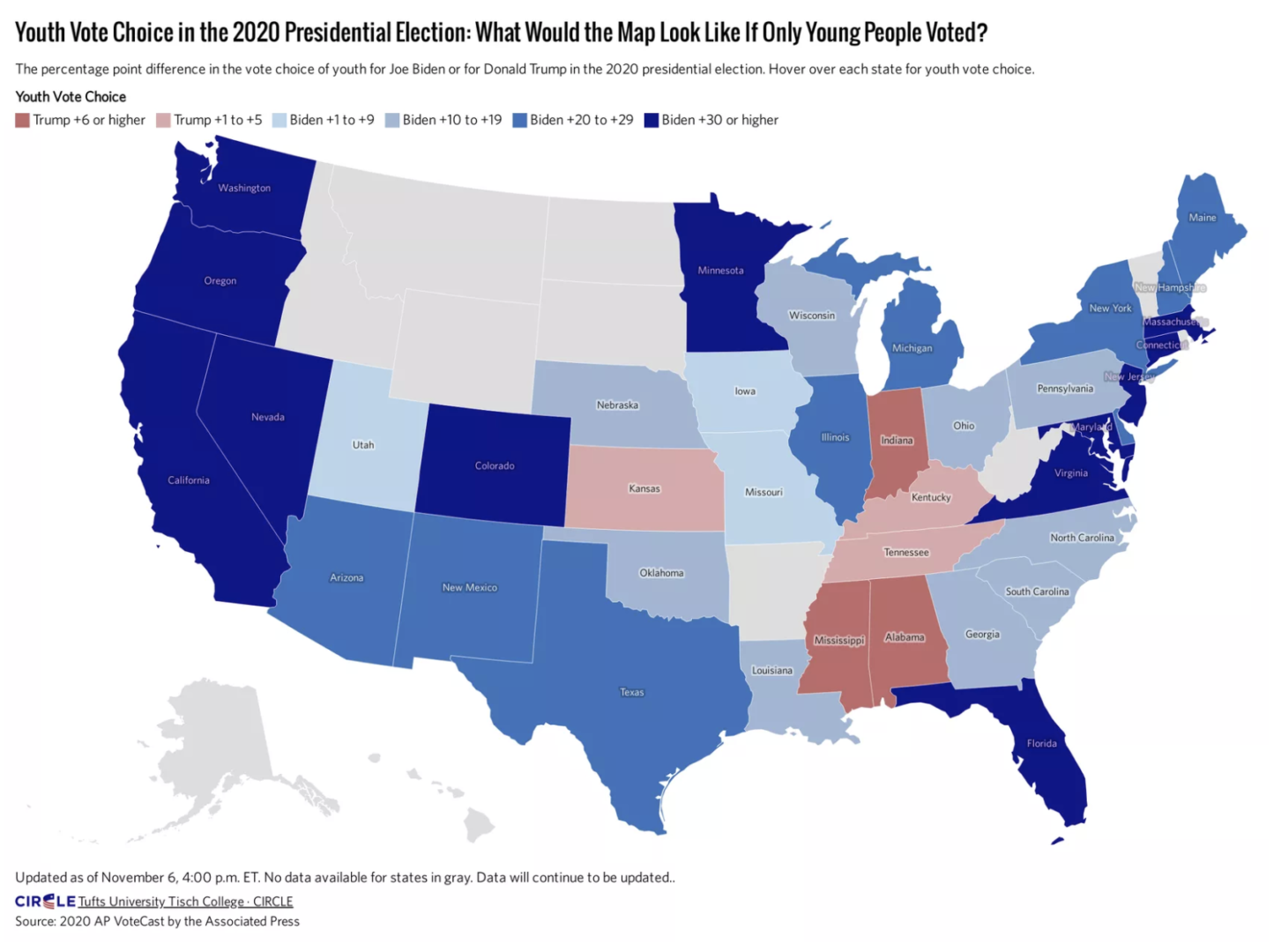This article is the final part of a six-part series detailing youth political subcultures and the role of youth political participation and activism in the past and present. By highlighting political activity at DU, this column seeks to find patterns in historical and present-day activism among youth populations. It hopes to shed light on how American youth populations view various political issues in different or similar ways from other youth voters and older generations.
It happened. After the high stress of election week, Joe Biden won the presidency. To many Americans, the fight is not over yet. President Trump continues to file lawsuits, and his supporters march down the Washington Monument avenue protesting his loss.
In true 2020 fashion, these are unprecedented times. Yet, one thing is for certain: as predicted, young people carried Joe Biden to victory. According to an analysis from Tuft University’s Center for Information and Research on Civic Learning and Engagement (CIRCLE), youth voters voted in higher numbers for Biden in the key swing states that decided his victory. As for the popular vote as a whole, The New York Times’ exit polls indicated that 60% of young people voted blue, while 36% stuck with Trump.

The sheer amount of young people who voted contributed to his win across the country since younger generations are largely more progressive and left-leaning. Based on CIRCLE’s data as of Nov. 9, “50%-52% of voting-eligible young people, ages 18-29, cast a ballot in the 2020 presidential election,” which is a 10% increase from youth voter turnout in 2016.
The last four years under Trump’s administration have seen a great deal of change in policies directly related to young people and students. Many young people cited specific policies that led them to vote in this election, taking an issue-based voting approach rather than wholly supporting one candidate. According to CIRCLE’s data, most young people (42%) cited the coronavirus as “their top issue” for voting in the election.

Considering so many young people cited specific policies as their main reasons for voting, how will legislation on youth-specific issues change over the next four years? To close out this column, I will look at how various college student issues might change with the incoming Biden administration.
Title IX:
As one of the most contentious issues among college students, Title IX is on the minds of many students as Joe Biden steps into the presidency. Established in 1972, Title IX is a legal provision “prohibit[ing] sex discrimination by schools that receive federal funding.” Sexual assault, harassment, stalking, violence against women and sex discrimination are all addressed by Title IX.
This is an issue deeply rooted in DU’s culture since the DU-based Instagram account @wecandubetter began in Jan. 2019. The page posts anonymous accounts of gender-based violence and sexual assault on campus, leading Chancellor Haefner to take immediate action. This issue is extremely prevalent around the nation as well, as around 19% of women and 5-6% of men experience sexual assault in college. In addition, many students have filed lawsuits against colleges, claiming the university violated their Title IX rights.
The current administration’s handling of Title IX has gone to Betsy DeVos, Trump’s controversial Secretary of Education. She has made adversaries of survivors of gender-based violence and advocates of its prevention.
DeVos and the Trump Administration made perhaps the most notable change to Title IX policy on May 6, 2020. The new regulations stirred uproar due to these notable changes: the definition of sexual harassment was limited to include only severe conduct; students cannot file Title IX reports if an incident occurred while they are studying abroad or at an off-campus location; and colleges do not have to comply with time restrictions. While the new regulations did officially qualify stalking, domestic violence and dating violence as sexual harassment, controversy still ensued as they give more protection to the accused rather than the victim. 18 states sued DeVos over the rulings during the past summer.
Joe Biden is looking to scrap many of these policies when he enters office. Biden mentioned he wants to re-implement Obama-era policies that place more power and protection with the victim rather than the accused. Biden also stated he wanted to “implement ‘annual, age-appropriate education on healthy relationships and affirmative consent’ in K-12 public schools.” However, these will not be easy tasks.
Many anti-rape advocates have said that the Biden administration cannot simply reinstate policies from Obama’s years; they need to address dating apps, which are now widely prevalent.
Many of these policy changes are also contingent on Biden’s Democratic party gaining control of the Senate.
Student finances and debt:
Throughout his years in office, President Trump did not make any headline-dominating changes regarding how the government handles student loans or debt. However, he did repeal the Obama-era borrower defense regulation, “which set up a process for canceling loans held by students whose colleges took advantage of them” in light of the Great Recession.
During his presidential run, Biden said he would forgive federal undergraduate tuition loans for those who attended historically-Black colleges and universities (HBCU) as well as public universities if they “earn less than $125,000 a year.” He also wants to “forgive $10,000 in student debt for all borrowers.” Biden called for a plan to have individuals pay off their student loans at 5% of their income per month in order to pay off the debt.
Other general changes:
Some of the most shocking changes during the Trump administration were regarding education. Recently, the administration sought to revoke student visas from international students unless they were enrolled in an in-person course. After multiple universities sued in opposition to the regulation, the administration dropped these plans. However, Trump also proposed fixed terms and restrictions on international student visas in September that would have placed further restrictions on international students who decide to remain in school past college. The administration has not implemented the law yet.
The Biden administration would ease up on visa restrictions and make it easier for foreign students to study in America. His website even states, “foreign graduates of a U.S. doctoral program should be given a green card with their degree… losing these highly-trained workers to foreign economies is a disservice to our own economic competitiveness.”
Additionally, Biden seeks to immediately repeal Trump’s famous January 2017 “travel ban” that limited entry of people from seven Muslim-majority countries into the United States. This order impacted approximately 17,000 students from the seven countries when it was enacted, and now impacts more after Trump extended the order to include 6 more countries barred from entry.
In terms of diversity and representation at American universities, Trump recently signed an executive order that banned diversity and racial sensitivity training in institutions that receive federal funding, which includes a significant number of colleges. Though he has not explicitly stated it, Biden will likely repeal this order as well.
Future questions:
In this column, I didn’t look for answers but rather patterns and more questions. We will never decisively be able to pinpoint the illustrious beast that is the American youth vote, but we must realize the power that young people have historically and currently in politics and American life.
During the next four years, I will be observing, both personally and journalistically, if youth of color still bear the brunt of activist work on college campuses and nationally, if young people will continue to turn out in historically large numbers without Trump’s positive or negative motivation. I want to find out if social media will continue to push voting or specific campaigns to young people under what will likely be a more “boring” Biden presidency. On a broader scale, I am curious to see how a young generation so disenchanted with the two-party system will work with or change it.
Although we will likely see major changes in the Trump-to-Biden transition, I urge all readers to ask themselves some key questions: Are you putting yourself in a political echo chamber? How does your social media fail or succeed in challenging your ideological beliefs? What types of people are underrepresented in the media and social movements? What are the main motivators behind your decision to vote or not?
I don’t have all the answers, but I do love asking the questions.











